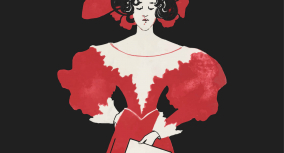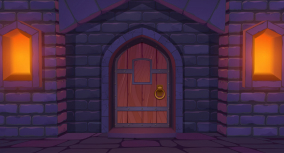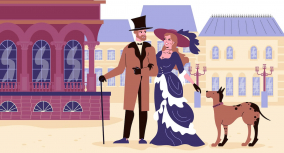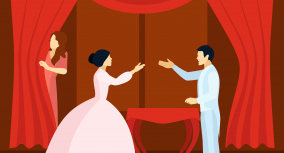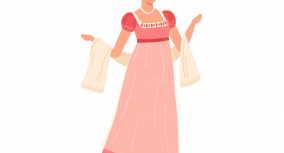As a critique of 19th-century gender norms, Ibsen’s A Doll’s House raises issues still relevant today: individual freedom, financial dependence, and power imbalance in marriage. The play’s format can be challenging, especially for those unfamiliar with drama, which is why A Doll’s House often leaves readers with more questions than answers.
On this page, Custom-Writing.org experts have collected here the most crucial Q&A about the play: just scroll through A Doll’s House short questions and answers below to get a better understanding of Ibsen’s work. Click any link to see a more detailed explanation on a separate page.
- How does A Doll’s House end?
A Doll’s House ending was considered somewhat scandalous back in the Victorian age. At the time, when women were supposed to be obedient wives and take care of the family, Nora’s decision to leave everything behind was not exactly socially acceptable. She chose independence and the path to self-discovery over her family despite her husband’s despair. - How is A Doll’s House relevant today?
A Doll’s House was written and presented to the public in 1879. It was the time when women had few rights. Ibsen used it as the central theme for his play, which was met with some criticism. However, we can’t ignore that the social issues he highlights weren’t relative back then. Moreover, they still are. - What is Nora’s secret in A Doll’s House?
Nora is the main character of the play, and we get to find out about her secret when Mrs. Linde comes to have a chat with her. It appears that Nora borrowed a large sum of money from Krogstad to pay for the trip to Italy. It was the only chance to help Torvald improve his health. - When was A Doll’s House first performed?
It didn’t take long for the play to go out to the public. A Doll’s House was first performed in December 1879, the same year Ibsen finished it. The Royal Theatre in Copenhagen was honored to offer the stage for it. Even though Henrik Ibsen was quite popular, this play didn’t meet such a massive success as people might think.
- Who is Mrs. Linde in A Doll’s House?
Mrs. Linde is Nora’s old friend who unexpectedly shows up at Helmer’s house at the beginning of the play. Her husband died, leaving her without any money, so she comes to ask for a job. She seems to be a sensible and understanding woman yet following the generally accepted social rules. - What is the setting of A Doll’s House?
The play is set in some random Norwegian town in the Victorian age. No details are describing the exact location and time of the events. However, even that little information about the setting can give you some insight into Ibsen’s style and intentions. It appears to be vaguely described on purpose. - What genre is A Doll’s House?
A Doll’s House is considered to be a drama. Ibsen presented it in the limits of one family. However, this issue concerns many people. At the same time, the play is also tragic, even though no character is shown dying. A Doll’s House introduces a conflict between an individual and society. - Why did European audiences find the character Nora in Henrik Ibsen’s A Doll’s House scandalous?
The mentality and perspective of people change with time. Therefore, we shouldn’t be shocked by the fact that the audience saw Nora as scandalous in the Victorian era. Back then, the whole of Europe had pretty traditional views on marriage, and women who leave their families behind just to self-explore were considered crazy. - What is the theme of A Doll’s House?
It would only be fair to claim that A Doll’s House‘s central theme is gender equality. Even though Ibsen masterfully raised many others, such as marriage and social code, they don’t seem to be as crucial in the play. Nora’s character represents the theme of gender roles and proves that social norms can be wrong. - What is A Doll’s House about?
A Doll’s House is Henrik Ibsen’s play which describes challenges that women of that time had to go through. We can only assume that this realistic piece was quite relevant in the Victorian era. The author pictures a life of an average Norwegian family that seems happy. However, everything starts escalating quickly when Nora’s secret is revealed.
- Which three themes are present in Ibsen’s A Doll’s House?
There are quite a few themes that Ibsen highlights in his play. A Doll’s House is a unique mix of drama and realism, which allows the author to work on relevant and essential topics. Marriage, gender roles, money, and society are only a few of the themes that open up throughout the play. - When does A Doll’s House take place?
A Doll’s House takes place at the same time period as when it was written. Nowadays, we call it the Victorian era, since those were the years of Queen Victoria’s reign. That time was characterized by specific social norms that dictated how marriages and families should be run. Ibsen highlights the theme of gender roles from a different perspective. - When was A Doll’s House written?
Henrik Ibsen wrote A Doll’s House in 1879. The same year the play was published and performed for the first time. It appeared to be a pretty revolutionary piece, from the perspective of both the perspective and genre. Ibsen’s play started up a trend for realistic writing. However, it wasn’t in favor of the social norms prevailing at the time. - Where does A Doll’s House take place?
The setting of Ibsen’s A Doll’s House is not totally clarified. It is only said that the play takes place in some city or town in Norway. Moreover, everything happens at Helmer’s house. There is a reason why the place is described so generally. Such a trick prevents the audience all around the world from distracting. - In what ways does Dr. Rank provide a contrast to Torvald in Henrik Ibsen’s A Doll’s House?
Dr. Rank is generally considered to be Torvald’s foil because of such different attitudes and behavior. The most sticking aspect is how the two men treat Nora. It is clear that Torvald doesn’t see his wife as an individual, which is one of the leading causes of her transformation. Meanwhile, Dr. Rank is just the opposite.


